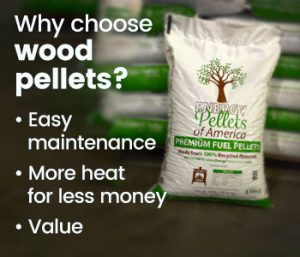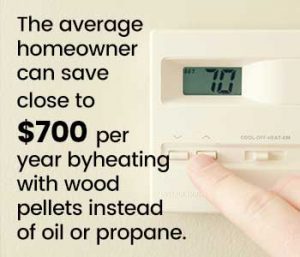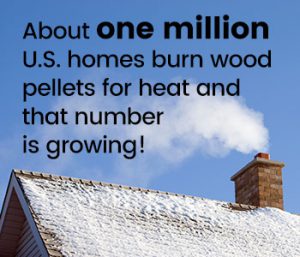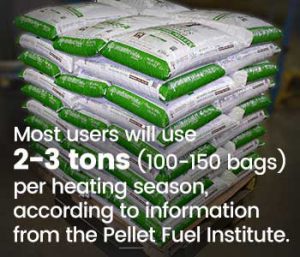Wood pellets are a practical and efficient want to hear your home. Take a look at wood pellets vs other sources of energy to compare and see which will work best for your needs.
Understanding the difference between wood pellets vs other sources of energy can help you make an educated choice about your home or business heating needs. There are many reasons why you might opt to heat your home with wood pellets.
What are Wood Pellets?
 Wood pellets are a heating fuel made from compressed wood fibers. These wood products are burned in pellet stoves, furnaces and boilers, and used to heat homes, businesses and commercial locations. Wood pellets are a renewable fuel source, easy to use, efficient and natural.
Wood pellets are a heating fuel made from compressed wood fibers. These wood products are burned in pellet stoves, furnaces and boilers, and used to heat homes, businesses and commercial locations. Wood pellets are a renewable fuel source, easy to use, efficient and natural.
Wood pellets are considered a biomass product, which means they come from from a growing, renewable energy source. Examples of biomass fuel include wood energy pellets, wood chips, cord wood, paper and agricultural byproducts used for energy and fuel.
Energy Pellets of American makes recycled wood pellets. Pellets are made from untreated shipping pallets that are no longer useful in the transportation industry. Recycled wood pellets help stop waste from entering landfills. These wood pellets are made through a simple, natural process:
- Energy Pellets of America finds retired, untreated shipping pallets that are broken and no longer useful in the shipping industry.
- The pallets are broken down into fine particles at our pellet plant by using a grinder and hammer mill. This turns the wood chips into a “sawdust” like material.
- Uses multiple magnets to remove nails, screws and other ferrous metal objects from the raw material.
- Compresses the remaining wood particles into dense pellets using a pelletizing mill. The pellet’s high density makes them burn consistently in your pellet stove or appliance. No additional chemicals are used in this process.
- The finished pellets are bagged and shipped via pallet to retail stores and home customers. Pellets are available in 40 lb bags or by the 1 ton pallet. From pallets to pellets, the product comes full circle when shipped on a pallet to its final destination.
The entire production and shipping process creates a wood pellet product that is accessible to consumers and is a clean source of energy.
About one million United States homes burn wood pellets for heat. This number is growing. Wood pellets frequently used to heat homes and businesses in Europe and around the world.
According to recent statistics from the Pellet Fuels Institute, the average homeowner can save money by heating with wood pellets instead of oil or propane. Average savings are close to $700 per year. Additionally, heating with wood pellets can cut carbon and greenhouse gas emissions by up to 5 metric tons each year.
Using Wood Pellets for Heat
 According to the U.S. Department of Energy, wood pellets provide clean burning, efficient and powerful heat for modern homes. Pellet heat can also be used for businesses and commercial locations.
According to the U.S. Department of Energy, wood pellets provide clean burning, efficient and powerful heat for modern homes. Pellet heat can also be used for businesses and commercial locations.
When using wood pellets for heat, it is important to choose the right size stove for your space. If you choose a stove that is too big, you might let your pellets burn at a low smolder to avoid overheating. This can cause waste and can increase air pollution. A too-small stove unit might not provide sufficient heat. Before using wood pellets for heat, you might want to discuss your needs with a reputable wood pellet stove dealer. A rule of thumb you might follow is a stove rated at 42,000 Btu can heat a 1,300-square-foot home while a stove rated at 60,000 Btu can heat a larger 2,000-square-foot-home.
New wood pellet burning stoves can be approved by the Environmental Protection Agency (EPA). Some new stoves feature catalytic combustors. A catalytic combustor allows your burn to occur at a lower temperature. This generates more heat while cleaning the combustion gas. High-efficiency pellet stoves also have lower emissions and are safer to use in many cases. High-efficiency pellets stoves burn more completely than other stoves. This helps to prevent a dangerous creosote buildup in the chimney.
It is also important to consider the placement of the wood pellet stove within your home or pace of business. Many stoves are essentially space heaters, so you might consider placing it in the room where you spend most of your time. Additionally, your stove should have a method for spreading heat through your home, like a blower or fan.
Wood Pellets vs Other Sources of Energy
You’ll find several options when it comes to sources of energy for heating your home or business. Wind and solar power are among the cutting edge of green energy sources, but wood pellets are a major player in the green energy game, too. See how wood pellets stack up to other sources of energy commonly used to heat homes in the U.S.
Electricity
Electric furnaces are among the most common heating sources. It’s reliable and convenient. No flames are produced. Heat is constantly available. There is no worry about storage of fuel with a electric furnace. Using electricity to heat your home can contribute to global warming, as much of the country’s electricity is generated by coal burning plants. However, running an electric furnace can be more expensive than other fuel sources, including wood pellets.
In many regions, electric furnaces are the preferred heating method. Heat is produced with electric heating elements. The heating elements are controlled by circuit breakers, which are hidden inside or outside the furnace’s cabinet. An electric furnace has a blower that brings air into the heating cabinet through the cold air return. From there, the air is then pushed through the heat exchanger. In the exchanger, heating elements heat up the air. The blower then sends the air throughout your home via ductwork.
One benefit of electric heat over other heating methods is that it doesn’t give off carbon dioxide. This makes electric heat safer for those in your home and for the environment. Additionally, electric furnaces don’t require a flue to take combustion gases outside. A downside of electric heat is the cost. If you are choosing to heat with electric, you might also select a heat pump to help make this heating method more cost efficient. Heat pumps move cool air out and bring warm air in. Heat pumps don’t generate heat, they simply move heat. During cool weather, heat pumps move cool air from your home. Curing hot weather, heat pumps remove warm air from your home. In more moderate or temperate climates, you might only choose a electric heat pump for your furnace needs.
Gas
Natural gas is a non-renewable fuel source. It can be controlled very easily. The flame is controlled with switches. A gas heating system is easy to operate, low maintenance and clean burning. Though gas can be cleaner burning than fuel sources like coal and oil, gas is a non-renewable fuel source. This means mean that gas is not as environmentally friendly as biomass fuel sources like wood pellets. Additionally, gas can be an expensive fuel source.
If your furnace burns natural gas, the heating process depends on a pilot light. This light ignites burners inside a combustion chamber. The heat produced within the combustion chamber goes into a heat exchanger. From here, the heat goes into the air. Temperature should raise to the climate set by the thermostat. Like with an electric furnace, the hot air is then moved through the home via ductwork.
There are a few risks associated with using a natural gas furnace. Gas furnaces can present a fire hazard. Gas furnaces need adequate ventilation to prevent fires. Boxes or storage shelves around a gas furnace can prevent proper ventilation and create a fire hazard. Additionally, solvents and other flammable liquids can let off vapors that could be ignited by the flame within a gas furnace. It is best to keep your furnace area clear. Gas line leaks can also create a risk for those using a gas furnace. A chemical smell is added to natural gas to help detect leaks. A leak in a gas line could be a catastrophic event. Carbon monoxide poisoning is also a risk for users of gas furnaces. Carbon monoxide poisoning can cause flu-like symptoms. Headache, nausea and dizziness are all symptoms of carbon monoxide poison.
Oil or Propane
 Oil and propane heaters and furnaces can be flexible heating sources for your home. However, these heating sources are not as clean burning as wood pellets. Additionally, oil and propane can be expensive. Heating with propane can cost up to 62 percent more than heating with wood pellets, according to the Pellet Fuels Institute. One ton of wood pellets has be same heating output as nearly 3 barrels of oil. This makes wood pellets a cleaner burning, more cost effective alternative to heating with oil or propane.
Oil and propane heaters and furnaces can be flexible heating sources for your home. However, these heating sources are not as clean burning as wood pellets. Additionally, oil and propane can be expensive. Heating with propane can cost up to 62 percent more than heating with wood pellets, according to the Pellet Fuels Institute. One ton of wood pellets has be same heating output as nearly 3 barrels of oil. This makes wood pellets a cleaner burning, more cost effective alternative to heating with oil or propane.
Oil-fired heating systems generally distribute heat through your home or business in one of three ways: hot water through baseboards, steam through radiators and warm air through vents. In each case, your thermostat sense the temperature of the room. When the temperature drops below the set number, the heating system kicks on to warm the room. When the oil burner comes on, heating oil moves from the tank to the burner. A pump turns the heating oil into a fine mist and the mist ignites in the combustion chamber. From there, the heat is distributed through the home or building, either via air ducts or warm water depending on the system.
The most common risk associated with oil or propane furnaces is carbon monoxide poisoning. Carbon monoxide poisoning can cause flu-like symptoms. Exposure to high levels of carbon monoxide may be lethal. Carbon monoxide can enter your your home or business through backdraft, which forces the gas down the chimney. Dirty chimneys can also lead to carbon monoxide poisoning. If you heat your home with oil or propane, it is important to get your furnace serviced each year to keep it in top operating condition.
Firewood or Cordwood
Another source of biomass fuel, firewood or cord wood is cut wood that is used in furnaces and boilers. Because cord wood can have a high moisture content, it doesn’t burn as clean as wood pellets. Additionally, cord wood can be more expensive than wood pellets.
Firewood is typically sold in a cord. A cord refers to the volume or amount of wood. Once upon a time, firewood was the only method used to heat homes and buildings. In the centuries that have since passed, many other heating methods have evolved. Despite the options available to consumers today, many people still choose to heat their homes or businesses with cord wood. There are a few advantages to using cord wood to heat your home. Wood is a renewable resource, unlike gas or coal. Additionally, many wood burning stoves can still produce heat during a blackout.
Like fossil fuel burning heating sources, burning cord wood can create carbon monoxide. The carbon monoxide can leak into your home or business space through a poorly ventilated system. Wood stoves that leak carbon monoxide might also leave black, sooty marks around the stove or fill a room with smoke. Both of these signs can be indicators of a faulty flue. The best way to prevent carbon monoxide poisoning is with a carbon monoxide detector. When the detector senses carbon monoxide, it sounds an alarm and alerts those around it of the danger.
Coal
 Coal is a traditional energy source that is made from fossil fuels. Coal is one of the most plentiful and inexpensive fossil fuels, making it accessible and easy to burn. Burning coal can be problematic, though. Scientific tests have found that burning coal releases many harmful gases into the atmosphere. Harmful gases like carbon dioxide and sulfuric acid are emitting by burning coal. These gases have been found to contribute to climate change. Wood pellets are a cleaner alternative to burning coal.
Coal is a traditional energy source that is made from fossil fuels. Coal is one of the most plentiful and inexpensive fossil fuels, making it accessible and easy to burn. Burning coal can be problematic, though. Scientific tests have found that burning coal releases many harmful gases into the atmosphere. Harmful gases like carbon dioxide and sulfuric acid are emitting by burning coal. These gases have been found to contribute to climate change. Wood pellets are a cleaner alternative to burning coal.
In many cases, coal furnaces are outside the home or building. Generally, coal furnaces are installed between 25 and 200 feet away from the building it will heat. Outdoor coal furnaces do not have a chimney and usually contain their own vent. Coal furnaces are often kept outdoors because coal burns at a very high temperature, in excess of 3,000 degrees Fahrenheit. A very thick firebox is required. The amount of coal needed depends on the size of the building you are heating and the weather, but 20-25 pounds a day is average. This adds up quickly. Because coal furnaces are often kept outside, hot water or hot air is transferred into the building through underground pipes. A pump is used to move the air or water. Heat is generally distributed through forced air, radiant floor heating and radiant baseboard heating.
Wood Pellet Burning Stoves and Appliances
 You’ll find many kinds of pellet-burning stoves and appliances on the market today. These stoves and appliances can help you maximize on wood pellets vs other sources of energy.
You’ll find many kinds of pellet-burning stoves and appliances on the market today. These stoves and appliances can help you maximize on wood pellets vs other sources of energy.
Catalytic Wood Stoves
Wood stoves are the most common appliances for heating with wood and wood pellets, according to the U.S. Department of Energy.
Catalytic wood stoves are advanced combustion stoves. These provide heat and work efficiently when the fire burns at full throttle. These stoves can reach burn temperatures of 1,100 degrees. This temperature is hot enough to burn combustible gases. These stoves have several parts that help them burn particulates and combustible gases. Catalytic wood stoves work by having a metal channel which heats secondary air. The heated air is fed into the stove above the fire. The air contains heated oxygen, which burns off the heated gases. The gases are burned above the fire.
There are a few benefits to choosing a catalytic wood stove. Catalytic wood stoves have efficiencies of 83 percent higher heating value (HHV). Newer non-catalytic stoves have efficiencies of 65 to 70 percent HHV. Another benefit is that catalytic wood stoves are easy to keep clean. The hot air is funneled toward the glass doors, burning off any residue that might linger. Additionally, catalytic wood stoves can be less expensive than traditional wood stoves fitted with catalytic combustors. Some catalytic wood stove systems can even switch to running on oil or gas should the flame go out.
Wood Pellet Fireplace Inserts
Generally speaking, wood pellets are designed to be used in pellet stoves, like catalytic wood stoves. However, you can burn wood energy pellets in your traditional fireplace with a few special products. Energy Pellets of America does not endorse any of these products, but you might explore your options to see what works best for your needs.
Pellets can be used in a fireplace with a special insert. A pellet tray or fireplace insert will hold the pellets in your stove or fireplace so you may use pellet fuel to heat your home without a special pellet stove. Inserts should be airtight. This will help you control the flame and heat output.
It is important that you have your fireplace set to maximum airflow when you’re using a wood pellet fireplace insert. The steps in using a fireplace insert are fairly simple:
- Put your pellet insert tray in the center of your fireplace or stove. An airtight fit will allow the pellets to burn better.
- From there, fill the tray with wood energy pellets. Follow the tray manufacturer’s instructions on the amount of pellets to use.
- Start the fire in the insert as you would normally start a fire in your fireplace. You might need to use kindling like paper and firelighters to start the fire.
- Let the pellets ignite.
- The pellets will burn. You will likely find that pellets burn longer and cleaner than other fuel sources.
After your burn, you’ll need to clean out your fireplace. Clear the ash from the inside of your tray. Keeping a clean fireplace and insert will help keep your burn efficient.
Masonry Heaters
Sometimes called, Russian, Siberian or Finnish fireplaces, masonry fireplaces produce heat for your home or business. Masonry heaters have a firebox, a brick or masonry mass, and twisty smoke channels that run through the masonry mass. Masonry heaters burn very hot.
The firebox is lined with special brick or concrete that can handle temperatures up to 2,000 degrees Fahrenheit.
Masonry heaters burn a small, hot fire. The fire’s gases are released through the channel’s tunnels. The heat from the fire is absorbed by the masonry and is slowly released throughout the home or business.
Many masonry heaters can be designed to burn wood pellets. Others are designed to burn other solid fuels. Because the fire is so small, minimal pollutants and gases are emitted. Additionally, minimal creosote builds up in the chimney. Most of the heat from the fuel burned travels through the masonry and is released slowly throughout the day. Because the heat is transferred and the fire burns so small, a masonry heater does not need to be loaded with fuel as often as with other wood pellet heating appliances. Because the burn is small and hot, minimal ash is created when using a masonry heater.
There are a wide variety of masonry heater designs. Some of the larger models might look like a fireplace and take up an entire wall. Smaller models might be the same size as a typical pellet stove. Masonry heaters can be custom built or come as prefabricated units. Installing a masonry heater is usually not a DIY venture, as quite a bit of masonry skill is required.
Why Choose Wood Pellets vs Other Sources of Energy
 There are many reasons why you might choose a wood pellet burning stove or appliance to heat your home. Burning wood pellets can be a better option than other sources of energy. In many cases, wood pellets are a more eco friendly and cost effective option than other heating sources. Other reasons you might choose wood pellets over other heating options include:
There are many reasons why you might choose a wood pellet burning stove or appliance to heat your home. Burning wood pellets can be a better option than other sources of energy. In many cases, wood pellets are a more eco friendly and cost effective option than other heating sources. Other reasons you might choose wood pellets over other heating options include:
- Easy maintenance. You’ll find that a 40 lb bag of Energy Pellets of America’s premium wood pellets contain less than 1 percent ash. This means our pellets are clean burning, which means less cleaning and maintenance for you.
- More heat for less money. Wood pellets provide a steady source of heat with a low level of emissions. Additionally, when used in stoves, boilers or furnaces, pellets provide the same heat as other sources for less money. Even when compared to other biomass fuels, wood pellets provide a clean burn and steady, even heat.
- Value. When compared to cordwood or natural gas heat, you’ll find that wood pellets are a much better value. A 1 ton pallet of Energy Pellets of America’s wood pellets has the heating value of approximately 1.5 cords of wood.
- Easy to store. Not only do wood pellets have a high heating value, they are also easy to store. A 1 ton pallet of wood pellets stores in about ⅓ of the space required to store a cord of wood. This makes wood pellets an easy-to-use heating solutions.
- Simplicity of use. Pellers burn cleanly and are efficient. Minimal soot and smoke are produced. Exhaust isn’t hot, so a masonry chimney isn’t required for use. Pellet stoves can be installed in almost any room in the house. Pellet furnaces and boilers can replace or work alongside your existing heating system.
- Easy to plan. Unlike oil, pellet fuel cost doesn’t fluctuate. Cost of wood pellets doesn’t change based on world events. This means consumers don’t have to deal with unpredictable heating costs. Biomass energy has a stable price.
Additionally, wood pellets are an eco friendly heating solution. Wood pellets are:
- Recycled. Energy Pellets of America makes wood pellets from retired shipping pallets that are no longer useful in the shipping industry. This creates a renewable energy source that prevents waste from going to landfills.
- Clean burning. According to information from the Environmental Protection agency, wood energy pellets are the cleanest burning solid fuel available. Because wood pellets are a renewable, clean burning energy source, little carbon is produced especially when compared to fossil fuels.
Additional Uses for Wood Pellets
Unlike other sources of energy, wood pellets have other applications. You might find find other applications for wood pellets around your home.
Pellet Ash
Did you know you can use the ash from your pellet burn in your garden? Pellet ash can be added to your garden soil in the spring or year-round and provides nutrients for the soil. Pellet ash contains potassium and lime, and can help neutralize your soil. To use pellet ash to fertilize your garden, simply collect the ash from your stove or appliance’s bin and apply it to the base of your plants.
You can also use pellet ash in your compost. Pellet ash can neutralize the pH level of your compost pile. A more neutral pile can help promote decomposition.
Cat Litter
Wood pellets are a great alternative to traditional clay cat litter. You can use wood pellets made for animal bedding or your pellet stove in your cat’s litter box. Energy Pellets of America’s are not chemically treated. This means our pellets are 100 percent natural and safe for your pet. Wood pellets absorb moisture and turn into sawdust when wet. This makes it easy to remove soiled pellets. Once removed from the box, soiled pellets can be added to your compost pile and disposed of naturally.
Animal Bedding
Many animal owners choose to use wood pellets in their animal habitats. You can buy special wood pellets made for animal bedding. These pellets absorb moisture in stalls and provide comfort and footing for your animal. You can use wood pellets as animal bedding in two ways: whole or moistened. Unlike wood shavings, straw and sawdust, animal bedding pellets won’t stick to fur, blankets and other bedding. Additionally, the low-dust formulation reduces the amount of particulate matter in the air to help avoid respiratory problems sometimes caused by breathing in fine particles.
How to Buy Wood Pellets
 Unlike sources of energy that come from a utility service like gas or electricity, you need to purchase wood pellets to use them in your home or business. You can buy wood pellets by the bag or by the ton. Bags hold 40 lbs of pellets. One ton of pellets contains 50, 40-lb bags. Purchasing by the ton can be more economical. Most users will use 2-3 tons per heating season, according to information from the Pellet Fuel Institute.
Unlike sources of energy that come from a utility service like gas or electricity, you need to purchase wood pellets to use them in your home or business. You can buy wood pellets by the bag or by the ton. Bags hold 40 lbs of pellets. One ton of pellets contains 50, 40-lb bags. Purchasing by the ton can be more economical. Most users will use 2-3 tons per heating season, according to information from the Pellet Fuel Institute.
You can buy wood pellets online or from a local dealer. There are many ways to get your wood energy pellets to your home or business. The most cost-effective option is to pick them up in person at Energy Pellets of America’s manufacturing facility in Wilmington, Ohio. You can pick up pellets by the bag or by the ton.
A more convenient method is to have the energy pellets shipped to your home, business or commercial site. Shipping rates might vary depending on the amount of pellet fuel purchased, where the pellets are being shipped, and delivery option selected. Once your order is processed, the carrier will contact you about the delivery of your wood pellets. Shipping time is generally between 1 and 2 business days, depending on your location. The carrier’s trucks are equipped with lift gates and are able to get your pellets off the truck and on the ground.
Pickup and delivery options make buying wood pellets simple.
Ready to Get Started with Wood Pellets?
Wood pellets are a clean-burning, versatile, and sustainable method of providing heat to your home, business or commercial enterprise. Energy Pellets of America makes recycled premium wood fuel pellets that can be used to fuel a pellet stove, furnace, boiler and more. Call us at (866) 200-8870 to learn more or place your order today.
